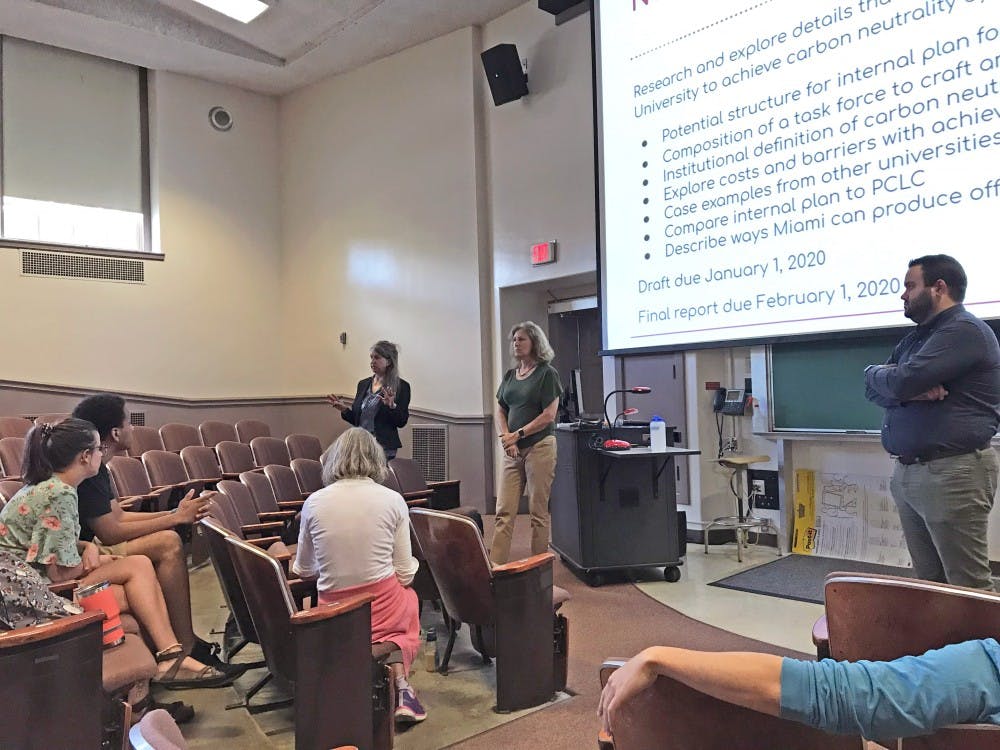Over two weeks ago, Miami University students led a climate strike and confronted Miami President Greg Crawford and the Board of Trustees (BoT) at Marcum Conference Center to demand they take a stand on several sustainability issues on campus.
In response to student outcry over Miami's lack of green policies, Miami’s Sustainability Committee held a public forum on Thursday, Oct. 3. The forum’s goal was to be more transparent about how Miami is addressing its climate impact.
The forum was scheduled less than a week before it was held. Despite a large student response to the climate strike, less than 20 students attended the forum.
Associate Director for the Institute for the Environment and Sustainability (IES), Suzanne Zazycki, Chair of Kinesiology and Health, Helaine Alessio, and Director of Sustainability Adam Sizemore spoke.
They discussed how the Sustainability Committee is tasked with addressing how Miami will reach carbon neutrality. The Committee is now analyzing two different options: the President’s Climate Leadership Commitments (PCLC) or an internal university plan.
The PCLC is an agreement signed by university presidents that binds the university to certain goals, like carbon neutrality and sustainability. The standards for this commitment are strict and require administrations to develop a Climate Action Plan within the first three years of signing the agreement. They also have to submit annual reports on efforts to reduce their carbon footprint.
In January 2019, the Sustainability Committee presented an outline of questions and sustainability benchmarks to Crawford. The vision plan included ten objectives, including whether Miami should aspire to become the most sustainable university in the U.S. and Crawford’s pending decision to sign the PCLC.
Zazycki emphasized Miami’s ongoing efforts to reduce its energy consumption and encourage sustainable practices among its peers.
“[Miami aspires to be] a leader among higher education institutions,” she said. “We feel that it is a mutual responsibility of all humans to work toward sustainability practices and it should be a collaborative effort, not necessarily with one designated champion.”
Zazycki said Miami has accomplished many of its goals since the creation of the Presidential Task Force on Environmental Sustainability in 2007 and the formation of the Sustainability Committee in 2009.
The university earned two Silver STARS ratings in 2013 and 2016 as well as a Gold STARS rating in 2019. By 2018, it reduced 45 percent of its energy consumption since 2008, earned several LEED Gold and Silver ratings and sponsored the creation of a Student Sustainability Council.
But there’s more work to be done.
Enjoy what you're reading?
Signup for our newsletter
Alessio said Crawford was waiting on the Sustainability Committee to provide more details on how Miami would fulfill the PCLC before making a decision on whether to sign. The Committee was also tasked with considering an internal plan for the university.
“In speaking with President Crawford, one of the things that he was pretty passionate about was a cultural change, not only at the administrative level, but at every level,” Alessio said.
“This isn’t just a plan that we’re working on for the administration to do and take care of the business of carbon neutrality on its own,” she said. “This is a plan that’s going to include everyone’s buy-in to make choices at the smallest level as well as the highest level that we can achieve carbon neutrality with everybody pitching in.”
Despite not attending the forum, climate strike organizer Cassie Conrad said she was optimistic about the ideas expressed during the Committee’s presentation.
“This [forum] is one of Crawford's first steps toward being more transparent with the student body,” she wrote in an email to The Miami Student. “Moving forward, I hope he commits to a sustainability communications team.”
After the forum, student leaders of the climate strike commented on their experience and their expectations of Miami’s future climate activism.
Associated Student Government (ASG) Secretary for Infrastructure and Sustainability Antonio Vazquez Lim wrote in an email to the Student that he was unsatisfied with the conduct of some strikers.
“The strike morphed into a political rally rather than a climate strike,” he wrote. “It succeeded in its goal to increase awareness of climate change, but it was misled in that it became vitriolic rather than productive … There was not much centralization and the strike was fractured in leadership.”
Vasquez Lim wrote that the purpose of the strike may have been misconstrued.
“Our goal was to increase awareness of climate change, especially within the student body,” Vasquez Lim wrote. “Our goal was never to force President Crawford's hand into signing the PCLC. There are other options for institutional carbon neutrality, and it is misleading to promote the PCLC rather than promoting just carbon neutrality.”
But Conrad and Vazquez Lim are still concerned.
“[In the] long-term nothing can be achieved without a real investment both financially and personnel-wise,” Conrad wrote. “I want to believe that Miami is headed in the right direction. At the very least, the students are being mobilized and there's much more interconnection between green [organizations] on campus than ever before.”
Vazquez Lim was critical of the breakdown of leadership during the strike, but optimistic about students’ passion to enact change on campus.
“Misled/misinformed activism is ineffectual, and there must always be a leader on these issues to guide those seeking to make change effectively,” Vazquez Lim wrote. “Being the change I want to see in the world is all I can do; it's essential that we continue to pursue a future for us and our children.”




